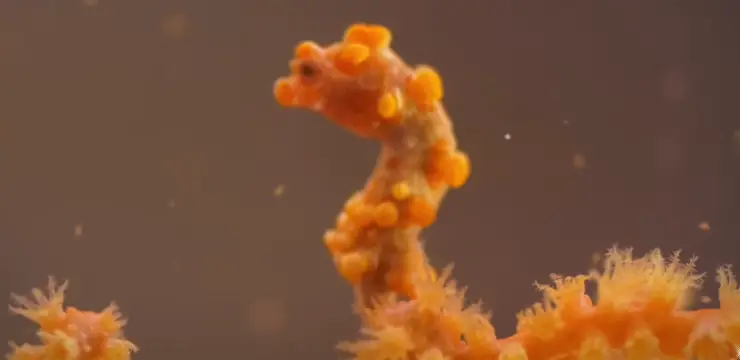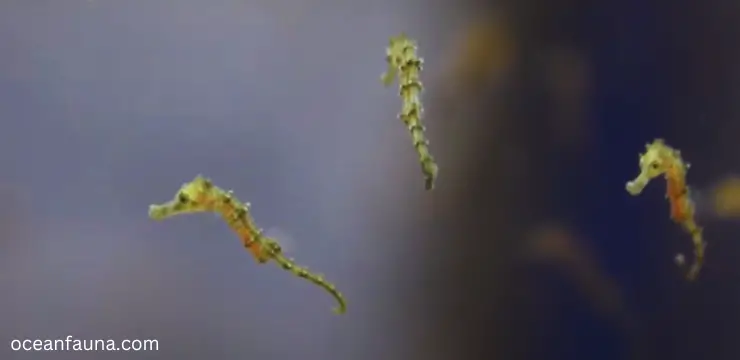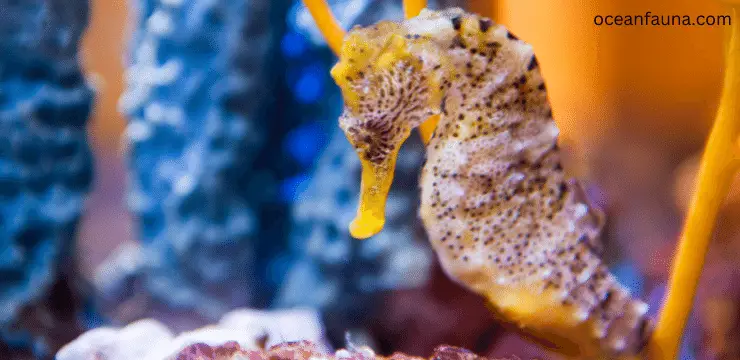Once baby seahorses are born, their parents provide no care or protection to them. The infants are released into the open sea, full of predators and dangerous animals. Upon getting released, the baby seahorses find their way out and survive fully on their own. They mostly take shelter around coral reefs, mangroves and bushy places to protect them from predators and survival.
Seahorses have an exceptional and unique living pattern that clearly differentiates them from other fishes. And their reproduction system is one of the most unique and jaw-dropping facts in the living world!
An adult seahorse ranges about a few inches in length. So you can imagine the size of baby seahorses, right? Being so tiny, if you’re curious to know about what happens to baby seahorses after birth, you’re at the right place.
Keep reading and learn more interesting facts about seahorses and know how they overcome the odds to survive in one of the most dangerous environments…
What Happens to Baby Seahorses After Birth?
I guess you already know that male seahorses give birth to their infants. Unlike other animals or fishes, seahorses have this unique reproduction system.
Male seahorses remain pregnant and carry the eggs in their pouch for about 3-4 weeks. And once the eggs are fertilised, they release their babies in the water.
When baby seahorses get released into the ocean or water, it’s up to them to survive. After the eggs are released, the job of the parent or male seahorse is done.
However, male seahorses do an interesting thing. That is, they release their babies at night. But why’s that? Well, this is done to protect the babies from predators during birth.
During the night or at low light, there’s a lesser chance of getting eaten by predators. So that’s why male seahorses release thousands of eggs in the ocean. And right after that, the bonding ends!
Do Parent Seahorses Protect Baby Seahorses After Birth?
No, parent seahorses don’t protect their babies after birth.
The job of male seahorses ends when the eggs are released into the water. And after that, they no longer take care of their babies. Baby seahorses have to survive on their own in rough and dangerous marine environments.
This is done not only by the male seahorses but also by the female seahorses as well. None of the parents take care of their babies, feed them or protect them from predators. This is one of the big reasons behind the low survival of baby seahorses.
How Baby Seahorses Survive with No Protection?

If you judge seahorses by their height and weight, that will be your biggest mistake. Being tiny in size, seahorses are one of the most clever and adaptable marine animals.
A mature male or female seahorse can be a few inches in length. Considering this, baby seahorses are only about a few centimetres in height. As parent seahorses provide no protection or care after birth, baby seahorses’ survival is astonishing!
Once born, the baby seahorses take shelter around coral reefs. The reason is baby seahorses have a higher chance of getting washed away by heavy currents. Moreover, the coral reefs help them to hide from predators.
On top of giving protection and shelter, baby seahorses also get food from there. Their main food is Plankton. And Plankton is found around coral reefs, seabeds, and mangroves.
How Many Baby Seahorses Survive in the Odds?
As said earlier, parent seahorses provide no protection or care to their babies. And that’s why the survival rate is too low!
A male seahorse lays about 2000 eggs at a time. And among them, only 10 seahorses survive roughly. So, the survival percentage is about 0.5%.
So, the question is, what happens to the rest? Well, as they’re tiny in size, most of the baby seahorses get washed away by heavy currents. At the same time, the others get eaten by predators.
Still, the ones that survive use a unique technique to live in a dangerous environment. Although baby seahorses can’t use the camouflage feature right after they’re born, they still somehow manage to hide themselves from predators!
Baby seahorses take protection in coral reefs, mangroves, and other bushy places. And from there, it takes food and grows up.
What Happens to Baby Seahorses After Birth in Aquariums?

Be it open oceans or aquariums, parent seahorses or male seahorses don’t give any protection to their babies.
Other than protection, baby seahorses should be kept separated from their parents for another reason also. In the seahorse’s world, male seahorses tend to eat their babies after birth as food. Yes, you might not believe it, but it is what it is!
So if you’re one of those who are planning to breed seahorses in aquariums, keep the fact mentioned above in mind.
There’s little chance of baby seahorses surviving in competition. So if you’re considering breeding them in aquariums, you should keep them separated in different tanks.
Using large water tanks or aquariums is recommended to keep around 2 to 3 pairs of seahorses.
On top of that, baby seahorses should be transferred to a separate water tank after they’re born. As a result, the survival chances will be high, and they’ll no longer be in danger of predators.
Baby seahorses take around 9 months to grow as big as their parents. So once the baby seahorses are all grown up, you can keep them with their parents in the same aquarium or tank!
Conclusion
Seahorses are truly an astonishing species. Their body structure, life cycle, reproduction method, and many other unique things.
Even with no protection from eh parents, baby seahorses survive in dangerous seas and oceans with being a few centimetres in height. Isn’t it miraculous? It indeed is!
So that’s it on knowing about what happens to baby seahorses after birth. We tried to give you a detailed idea about this. Also, we covered a few relevant topics that were associated with it. Hope this guide was helpful to you and you got what you wanted to know!


2 thoughts on “What Happens to Baby Seahorses After Birth?”